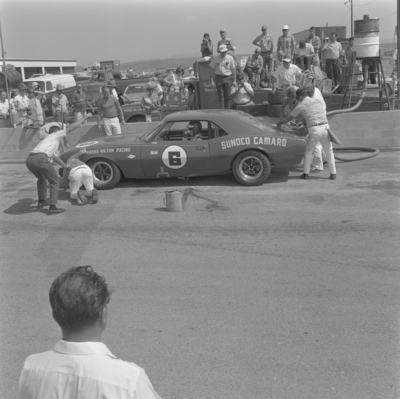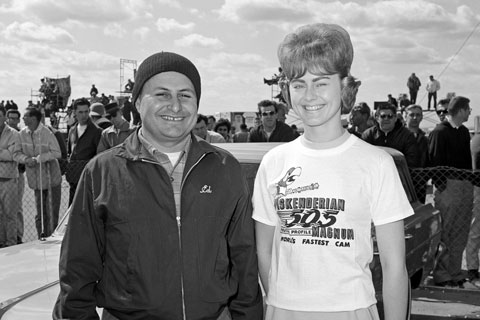SEMA News—December 2020
HERITAGE
Cool Fuel
By Drew Hardin
Photography by Eric Dahlquist, Petersen Publishing Company Archive
 |
Mark Donohue’s Sunoco-blue Penske-Hilton Camaro dominated the ’68 Trans-Am season, winning 10 of the series’ 13 races (including eight in a row). Donohue had such a big points lead over the teams backed by Ford and American Motors going into the Mission Bell 250 that Motor Trend’s Eric Dahlquist wondered in a December 1968 article, “The Race for Second,” if the Penske crew would even show up at Riverside Raceway.
But show up they did, and they took the race as seriously as ever, even with such a commanding lead in the series. Donohue captured the pole position, setting a course record and becoming the first sedan driver to average 100 mph around the Riverside track.
One secret to Donohue’s success was power. “Donohue was trying out a new cam,” plus “slightly redesigned” combustion chambers in the 302 V8’s alloy heads, Dahlquist reported. Those and “a very limited-edition cross-ram dual four-barrel manifold that looks like a junior edition of a Chrysler NASCAR Hemi manifold” helped the small-block make between 455 and 460 hp at 7,000 rpm. Ford’s tunnel-port 302, on the other hand, topped out at 440 hp at 8,000 rpm (and was notoriously unreliable during the season), while the 290-derived AMC mill made just 435 horses at 7,000 rpm.
And then there were Penske’s pit stops, which were as quick and efficient as those done by NASCAR’s famous Wood Brothers, Dahlquist wrote. Penske himself, quoted in Dave Friedman’s “Trans-Am, the Pony Car Wars 1966–1972,” said “our pit stops were a critical part of our program, and we practiced them continuously. If you check the records, you will find that Mark won numerous races because our pit crews could get him in and out of the pits faster than much of our competition.”
In Dahlquist’s photo of this pit stop for fuel, Donohue replenished his fluids while Penske, at the front of the car in the light shirt and dark slacks, supervised the activity.
Notice the two-tone drum at the upper right of the photo? That’s the pit fuel tank, and the white lower color isn’t paint—it’s frost. Penske’s team had figured out that cold fuel contracts, so they placed a 30-gal. fuel tank inside the 55-gal. drum and then packed the drum with acetone and dry ice. At 42°F, the Sunoco 260 race gas shrunk so much that 23 gal. would fit in the Camaro’s 22-gal. tank.
“The advantage Donohue gets from the cool fuel is difficult to calculate, since his Camaro holds the track record for gas gulping as well as speed, but he might otherwise be seriously handicapped,” Dahlquist wrote.
The heat was oppressive on that day in early September. Dahlquist said that ambient temperatures were well over 100°F, and Friedman said that tire engineers recorded a track temperature of 133°F.
“The intense heat extracted a terrible toll,” Dahlquist wrote. “Temperature and oil-pressure gauges replaced the tachometer as a speed governor—the higher the former got, the lower the latter became and the slower you went.”
Donohue’s Camaro was not immune. The “seemingly invincible machine began smoking and finally retired on lap 60 with a burned piston,” Dahlquist said. A “surprised” Horst Kwech, driving the number-two Mustang on Carroll Shelby’s team, took the lead and eventually won the race, with Peter Revson’s Javelin coming in second.






